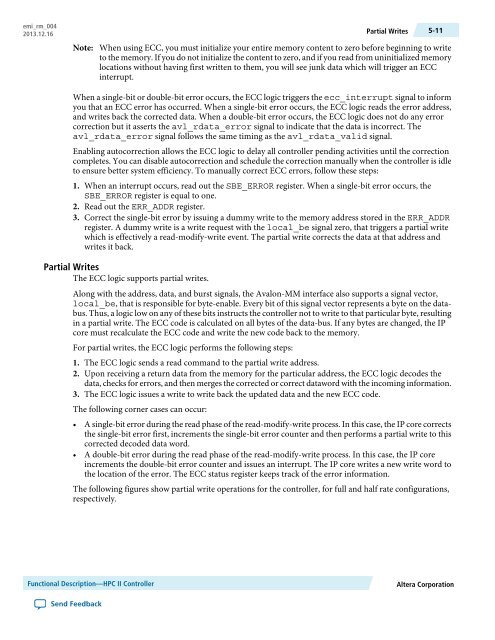Functional Description -- HPC II Controller, External Memory ... - Altera
Functional Description -- HPC II Controller, External Memory ... - Altera
Functional Description -- HPC II Controller, External Memory ... - Altera
You also want an ePaper? Increase the reach of your titles
YUMPU automatically turns print PDFs into web optimized ePapers that Google loves.
emi_rm_004<br />
2013.12.16<br />
Note:<br />
Partial Writes<br />
When using ECC, you must initialize your entire memory content to zero before beginning to write<br />
to the memory. If you do not initialize the content to zero, and if you read from uninitialized memory<br />
locations without having first written to them, you will see junk data which will trigger an ECC<br />
interrupt.<br />
5-11<br />
When a single-bit or double-bit error occurs, the ECC logic triggers the ecc_interrupt signal to inform<br />
you that an ECC error has occurred. When a single-bit error occurs, the ECC logic reads the error address,<br />
and writes back the corrected data. When a double-bit error occurs, the ECC logic does not do any error<br />
correction but it asserts the avl_rdata_error signal to indicate that the data is incorrect. The<br />
avl_rdata_error signal follows the same timing as the avl_rdata_valid signal.<br />
Enabling autocorrection allows the ECC logic to delay all controller pending activities until the correction<br />
completes. You can disable autocorrection and schedule the correction manually when the controller is idle<br />
to ensure better system efficiency. To manually correct ECC errors, follow these steps:<br />
1. When an interrupt occurs, read out the SBE_ERROR register. When a single-bit error occurs, the<br />
SBE_ERROR register is equal to one.<br />
2. Read out the ERR_ADDR register.<br />
3. Correct the single-bit error by issuing a dummy write to the memory address stored in the ERR_ADDR<br />
register. A dummy write is a write request with the local_be signal zero, that triggers a partial write<br />
which is effectively a read-modify-write event. The partial write corrects the data at that address and<br />
writes it back.<br />
Partial Writes<br />
The ECC logic supports partial writes.<br />
Along with the address, data, and burst signals, the Avalon-MM interface also supports a signal vector,<br />
local_be, that is responsible for byte-enable. Every bit of this signal vector represents a byte on the databus.<br />
Thus, a logic low on any of these bits instructs the controller not to write to that particular byte, resulting<br />
in a partial write. The ECC code is calculated on all bytes of the data-bus. If any bytes are changed, the IP<br />
core must recalculate the ECC code and write the new code back to the memory.<br />
For partial writes, the ECC logic performs the following steps:<br />
1. The ECC logic sends a read command to the partial write address.<br />
2. Upon receiving a return data from the memory for the particular address, the ECC logic decodes the<br />
data, checks for errors, and then merges the corrected or correct dataword with the incoming information.<br />
3. The ECC logic issues a write to write back the updated data and the new ECC code.<br />
The following corner cases can occur:<br />
• A single-bit error during the read phase of the read-modify-write process. In this case, the IP core corrects<br />
the single-bit error first, increments the single-bit error counter and then performs a partial write to this<br />
corrected decoded data word.<br />
• A double-bit error during the read phase of the read-modify-write process. In this case, the IP core<br />
increments the double-bit error counter and issues an interrupt. The IP core writes a new write word to<br />
the location of the error. The ECC status register keeps track of the error information.<br />
The following figures show partial write operations for the controller, for full and half rate configurations,<br />
respectively.<br />
<strong>Functional</strong> <strong>Description</strong>—<strong>HPC</strong> <strong>II</strong> <strong>Controller</strong><br />
<strong>Altera</strong> Corporation<br />
Send Feedback
















